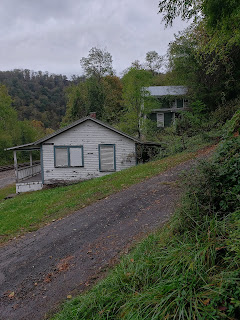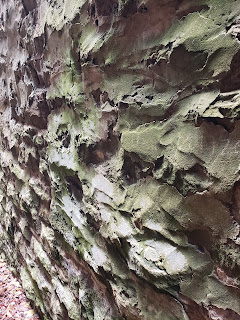Still more photos from Thurmond. Can you tell I loved the place? And have added yet another abandoned railroad town to visit--Nuttalburg. We just need to find a time to go there.
We didn't venture up this curving road; that will be for our next trip to Thurmond. What will we find, I wonder?
The red house is privately owned, and is being renovated with an eye to overnight rentals. How I would love to stay there, just for one night, and wander the town in the dark.
Under the tangle of vines and overgrowth is a low building. What was it? No idea.
I was trying to photograph a flower, and ended up with this spooky picture instead.
Surprise! Trucks can go on railroad tracks too--as long as the truck has specially fitted wheels, that is. CSX maintenance crew, passing by and waving.
Porches--I do like them. This one makes me wonder, who sat out here, waving at the trains?
More vines; not sure what this one is, but the color was arresting.
Another porch. Larry would not go back here with me; he was worried about copperhead snakes, which is a real possibility in this rocky, overgrown environment. This porch is actually right up against the hillside and must have been a cool retreat on hot days, and a sheltered one in cold weather.
One of the houses now belonging to the parks service.
Vines and vines, this one English ivy which is not native. I wonder if there was a flower garden up on the bank?
Wild asters bloomed in profusion on the hillside.
Hideaway? Well, it was once a home, now in the care of the park service.
Such nice work went into building the bank; this carved stone caught my eye.
Remember the alley I referred to in yesterday's post?
What intrigued me, besides its steep slope, was the stone and brickwork. Here, you can see that the masons didn't bother to finish the stonework, since it was hidden away up the alley.
And here, from almost the top of the alley, looking down, you can kind of see where the rough finished stone meets the finished, on the right.
Beautiful work on this arched window opening.
And here, some very rough, inexpert work closing in one of the window. Surely not the work of a trained mason.
The unfinished stone, yet again.
And here, the finished stone. This was very likely the work of Spanish or Italian masons, who were the primary stonemasons in West Virginia during the boom years of coal, timber, oil and gas production.
I was intrigued by this perspective.
Here is what is called dry-laid stone, with no mortar between the joints. Can you tell I'm married to a former mason?
I think this is a fig tree? Growing out of the stone wall above. What an odd thing to find.
And now I will close the door on Thurmond with one last door photo.
Until our next visit, that is.
Copyright Susanna Holstein. All rights reserved. No Republication or Redistribution Allowed without attribution to Susanna Holstein.



























This town looks like a great place to explore. Love those old buildings and all the brick work. The buildings all have character and I'm sure some interesting stories to tell. I enjoyed seeing your photos from Thurmond.
ReplyDeleteAbandoned towns make me sad. So many stories locked away in the buildings.
ReplyDelete